|
This image was created at Nickerson Beach, Long Island NY on the recently concluded Nickerson Beach Baby Beach Nesting Birds IPT with the tripod-mounted Canon EF 600mm f/4L IS II USM lens, the Canon 2x EF Extender III (Teleconverter), and the Canon EOS-1D X Digital SLR camera. ISO 800. Evaluative metering +1 1/3 stops: 1/160 sec. at f/10 in Manual Mode. Central sensor Expand (by necessity)/AI Servo/Rear Focus AF just in front of the chick’s eye active at the moment of exposure. Click here if you missed the Rear Focus Tutorial. Click on the image to see a larger version. This is the tiny, younger of the two chicks, the one that had been attacked. Note the prominent egg tooth. |
Thanks Pat!
Alan and Pat Lillich have been on about a zillion IPTs, most recently on both the Holland Tulip IPT and the Texel follow-up. When I first met Alan, on a San Diego IPT in 2011 (I just checked–I thought that it was a lot longer ago than that), I did not like him a whole lot. He used Nikon and seemed to know everything. Over the next few trips I learned that I was wrong. Simply put, Alan is a nice guy who consistently goes out of his way to to help others. He still knows a lot about the technical side of photography and computers–he is recently retired from Adobe, and is an excellent photographer as well. Just yesterday morning he stood in the parking lot of the Best Western Mill River Manor in Rockville Center for well more than an hour teaching co-leader Denise Ippolito to use her new Canon 24mm tilt shift lens; typical Alan Lillich.
As nice as Alan is, wife Patricia is definitely his better half. Pat is sweet as sugar, and is a skilled artist, sculptor, and photographer. Pat was standing at the colony ropes photographing some tern babies. I saw one mostly hidden behind a beach plant. Pat volunteered, “Artie, do you see the tiny chick laying on the sand right in front of you?” I had not until she pointed it out. “It was hiding in a small plant when an adult tern landed nearby, grabbed the tiny chick, and flung it to the ground.” Where it lay helplessly looking right at us. I was already set up with the 600 II and the 2X II TC so I quickly went to work.
I spend a good deal of time on IPTs pointing out situations to folks, birds in nice settings, action that might occur. But lots of eyes are always better than a single pair so I often am able to learn from others on the trip. In this case I was able to make a wonderful series of images thanks to Patricia Lillich.
Thanks a stack Pat!
|
This image was created at Nickerson Beach, Long Island NY on the recently concluded Nickerson Beach Baby Beach Nesting Birds IPT with the tripod-mounted Canon EF 600mm f/4L IS II USM lens, the Canon 2x EF Extender III (Teleconverter), and the Canon EOS-1D X Digital SLR camera. ISO 800. Evaluative metering +1 stop: 1/160 sec. at f/10 in Manual Mode. Central sensor Expand (by necessity)/AI Servo/Rear Focus AF just in front of the bend of the chick’s wing stub active at the moment of exposure. Click here if you missed the Rear Focus Tutorial. Click on the image to see a larger version. This is the older, more rambunctious chick. |
Snapper Blue
While one of the adults began to brood the tiny helpless chick its mate landed nearby with a baby bluefish. When I was a kid living in Brooklyn we used to catch snapper blues not much bigger than the one in the image and fry them up crispy, bones and all, for lunch. By now a few folks had gathered around photographing; all were amazed when the helpless chick’s older sibling swallowed the whole thing after about 3 minutes of trying.
Thanks again Pat!
|
This image was created at Nickerson Beach, Long Island NY on the recently concluded Nickerson Beach Baby Beach Nesting Birds IPT with the tripod-mounted Canon EF 600mm f/4L IS II USM lens, the Canon 2x EF Extender III (Teleconverter), and the Canon EOS-1D X Digital SLR camera. ISO 800. Evaluative metering +1 1/3 stop: 1/125 sec. at f/10 in Manual Mode (we lost a bit of light after the two frames above were created). Manual Focus on the chick’s eye. Click on the image to see a larger version. Here you can barely see the tiny chick’s foot as it is being brooded by one of the adults. The older chick is waiting momentarily to join its nest-mate. Note the far less prominent egg tooth of the older chick. |
Why Manual Focus?
For the answer to this very important question for all 1D X owners, see the answer in a blog post coming soon. Anyone want to hazard a guess?
200-400 Note
Please understand that though I had the new 200-400 on the beach when I made these images and though I do love the lens, the 600 II with the 2X III was the right tool for the the job in these situations. That combo gave me a focal length of 1200mm. The 200-400 with the internal TC in place and an external TC added works out to only 784mm. With the size of the subject in the frame being a function of the square of the focal length the huge advantage of reach goes to the 600II/2X III combo hands down. As in a 144 to 61.5 advantage (the relative squares of the two focal lengths).
|
This image was created at Nickerson Beach, Long Island NY on the recently concluded Nickerson Beach Baby Beach Nesting Birds IPT with the tripod-mounted Canon EF 600mm f/4L IS II USM lens, the Canon 2x EF Extender III (Teleconverter), and the Canon EOS-1D X Digital SLR camera. ISO 800. Evaluative metering +1 1/3 stop: 1/160 sec. at f/10 in Manual Mode (it brightened back up). Central sensor Expand (by necessity)/AI Servo/Rear Focus AF on the chick’s eye and re-compose. Click here if you missed the Rear Focus Tutorial. Click on the image to see a larger version. Here the older chick has found a surely less comfortable place at the inn. |
What a Privilege
What a privilege it to spend four days watching the life and death struggles of the Nickerson’s beach nesting birds. We saw copulating Black Skimmers. We got to photograph chicks that were only hours old. We saw fledged young take a fish from one of their parents only to be slammed by three others and lose its valuable meal. And we saw two Common Tern chicks taken by Great Black-backed Gulls and swallowed whole. Be sure to see BAA Bulletin #446 (coming soon) for the complete Nickerson Beach IPT Report.
White Balance
While I usually work in Auto White Balance all of the images here were created at K6000 for a warmer look. I started in the pre-dawn at K-1000 and worked my way down in 500-1000 unit increments to K6000 as the day brightened a bit.
Your Favorite?
Take a moment to leave a comment and let us know which of the four images here you like best. And be sure to let us know why.
Photographic Society of Chattanooga Seminar
Scroll down here for details on the Saturday seminar that Denise Ippolito and yours truly are doing in Chattanooga on October 12, 2013 and the follow-up Old Car City In-the-Field Workshop. Blog folks who sign up for both are invited to join us at a secret Urbex location in Atlanta on Friday morning October 11. Feel free to e-mail me for details after you are registered for both.
|
Snow Goose composite, Bosque del Apache NWR, San Antonio, NM. Click on the image for a larger version. |
Bosque del Apache 2013 IPT: “The Complete Bosque Experience.” NOV 26-DEC 2, 2013. 7-FULL DAYS: $3399. Co-leader: Denise Ippolito. Introductory Slide program: 6:30 pm on 11/25. Limit: 12.
Tens of thousand of Snow Geese, 10,000 Sandhill Cranes, ducks including point-blank American Wigeon and Wood Duck, amazing sunrises, sunsets, and blast-offs. Live, eat, and breathe photography with one of (if not the) world’s premier photographic educators at one of his very favorite locations on the planet. Top-notch Photoshop instruction. This will make 19 consecutive Novembers at Bosque for me. Nobody knows the place better than I do. Join us to learn to think like a pro, to recognize situations and to anticipate them based on the weather, especially the sky conditions, the light, and the wind direction. Every time we make a move we will let you know why. When you head home applying what you learned will prove to be invaluable. Includes all lunches and the Thanksgiving Buffet at the Crowne Plaza in Albuquerque. I hope that you can join me for what will be an unparalleled learning experience.
A $500 non-refundable deposit is required to hold your slot for this IPT. Your balance is due 4 months before the date of the IPT and is also non-refundable. If the trip fills, we will be glad to apply a credit applicable to a future IPT for the full amount less a $100 processing fee. If we do not receive your check for the balance on or before the due date we will try to fill your spot from the waiting list. If your spot is filled, you will lose your deposit. If not, you can secure your spot by paying your balance.
Please print, complete, and sign the form that is linked to here and shoot it to us along with your deposit check (made out to “Arthur Morris.”) You can also leave your deposit with a credit card by calling the office at 863-692-0906. If you register by phone, please print, complete and sign the form as noted above and either mail it to us or e-mail the scan. If you have any questions, please feel free to contact me via e-mail.
|
Images copyright 2012: Denise Ippoltio & Arthur Morris. Card design by Denise Ippolito. Click on the image to enjoy a spectacular larger version. |
Holland 2014 7 1/2-Day/8-Night: A Creative Adventure/BIRDS AS ART/Tulips & A Touch of Holland IPT. April 17-April 24, 2014 :$4995 Limit: 12 photographers/Openings 9
This trip needs 8 registrants to run so please do not purchase your plane tickets until you hear from us; right now we need 5 more folks.
Join Denise Ippolito, Flower Queen and the author of “Bloomin’ Ideas,” and Arthur Morris, Canon Explorer of Light Emeritus and one of the planet’s premier photographic educators for a great trip to Holland in mid-April 2014. Day 1 of the IPT will be April 17, 2014. We will have a short afternoon get-together and then our first photographic session at the justly-famed Keukenhof. Most days we will return to the hotel for lunch, image sharing and a break. On Day 8, April 24, we will enjoy both morning and afternoon photography sessions.
The primary subjects will be tulips and orchids at Keukenhof and the spectacularly amazing tulip, hyacinth, and daffodil bulb fields around Lisse. In addition we will spend one full day in Amsterdam. There will be optional visits the Van Gogh Museum in the morning and the Anne Frank House in the afternoon; there will be plenty of time for street photography as well. And some great food. On another day we will have a wonderful early dinner at Kinderdijk and then head out with our gear to photograph the windmills and possibly some birds for those who bring their longs lenses. We will spend an afternoon in the lovely Dutch town of Edam where we will do some street photography and enjoy a superb dinner. All lodging, ground transportation, entry fees, and meals (from dinner on Day 1 through dinner on Day 8) are included.
For those who will be bringing a big lens we will likely have an optional bird photography afternoon or two. If we get lucky, the big attraction should be gorgeous Purple Herons in flight at a breeding marsh. We would be photographing them from the roadside. And we might be able to find a few Great-crested Grebes at a location near Keukenhof.
Click here for complete details and some previously unpublished images. And/or click here and see item one for lots more tulip photos and complete trip details.
Click here for complete details and some previously unpublished images. And/or click here and see item one for lots more tulip photos and complete trip details.
|
Images courtesy of and copyright 2012: Bill Mueller. Card design by Denise Ippolito. |
Old Car City Creative Photography In-the-Field HDR Workshop: Sunday, October 13, 2013/ 9am till 1pm.
White, Georgia: $250 plus a $15 entrance fee donation (cash only on the day of the event) that will go to charity. Limit: 16 photographers.
On October 13, 2013, Arthur Morris/BIRDS AS ART and Denise Ippolito/A Creative Adventure will be conducting an In-the-Field HDR Workshop at Old Car City in White, Georgia. Old Car City is about an hour north of Atlanta, GA and an hour south of Chattanooga, TN where they will, as noted above, be doing a full day seminar for the Photographic Society of Chattanooga on Saturday, October 12th. Click here for complete details.
Typos
On all blog posts, feel free to e-mail or leave a comment regarding any typos, wrong words, misspellings, omissions, or grammatical errors. Just be right. 🙂
Support the BAA Blog. Support the BAA Bulletins: Shop B&H here!
We want and need to keep providing you with the latest free information, photography and Photoshop lessons, and all manner of related information. Show your appreciation by making your purchases immediately after clicking on any of our B&H or Amazon Affiliate links in this blog post. Remember, B&H ain’t just photography!




Support the Blog


Amazon
Everyone buys something from Amazon, be it a big lens or deodorant. Support the blog by starting your search by typing in the little white box below. No purchase is too small to be appreciated; they all add up. Why make it a habit? Because I make it a habit of bringing you new images and information on an almost daily basis.
And from the BAA On-line Store:
LensCoats. I have a LensCoat on each of my big lenses to protect them from nicks and thus increase their re-sales value. All my big lens LensCoat stuff is in Hardwood Snow pattern.
LegCoat Tripod Leg Covers. I have four tripods active and each has a Hardwood Snow LegCoat on it to help prevent further damage to my tender shoulders 🙂 And you will love them in mega-cold weather….
Gitzo GT3532 LS CF Tripod. This one replaces the GT3530LS Tripod and will last you a lifetime. Learn more about this great tripod here.
Mongoose M3.6 Tripod Head. Right now this is the best tripod head around for use with lenses that weigh less than 9 pounds. For heavier lenses, check out the Wimberley V2 head.
Double Bubble Level. You will find one in my camera’s hot shoe whenever I am not using flash.
The Lens Align Mark II. I use the Lens Align Mark II pretty much religiously to micro-adjust all of my gear an average of once a month and always before a major trip. Enjoy our free comprehensive tutorial here.
BreezeBrowser. I do not see how any digital photographer can exist without this program.
Delkin Flash Cards. I use and depend on Delkin compact Flash Cards and card readers most every day. Learn more about their great 700X and 1000X cards here or about my favorite Delkin card here.

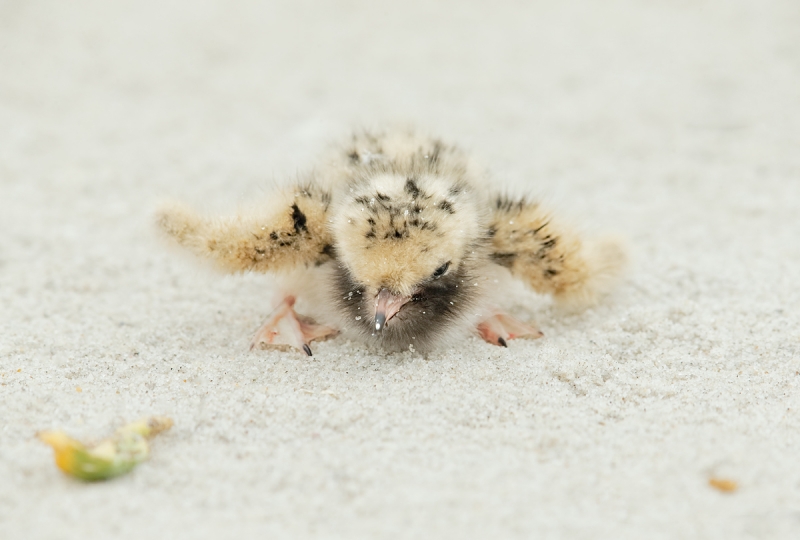
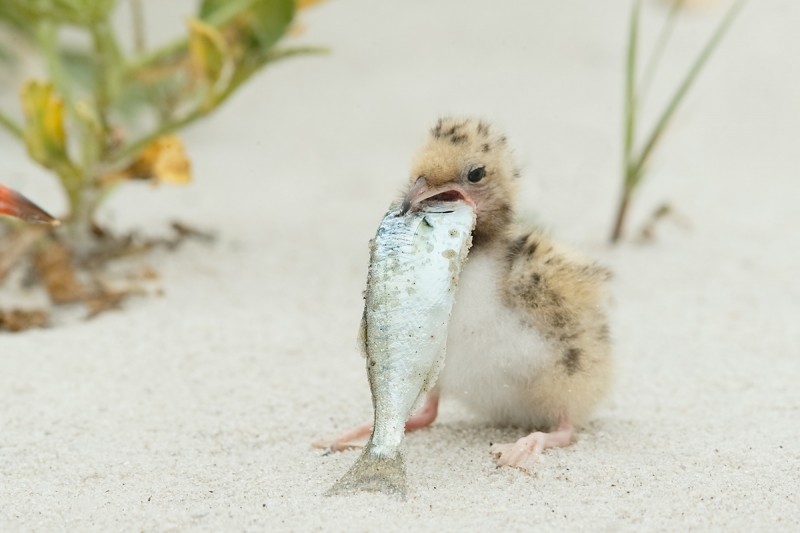
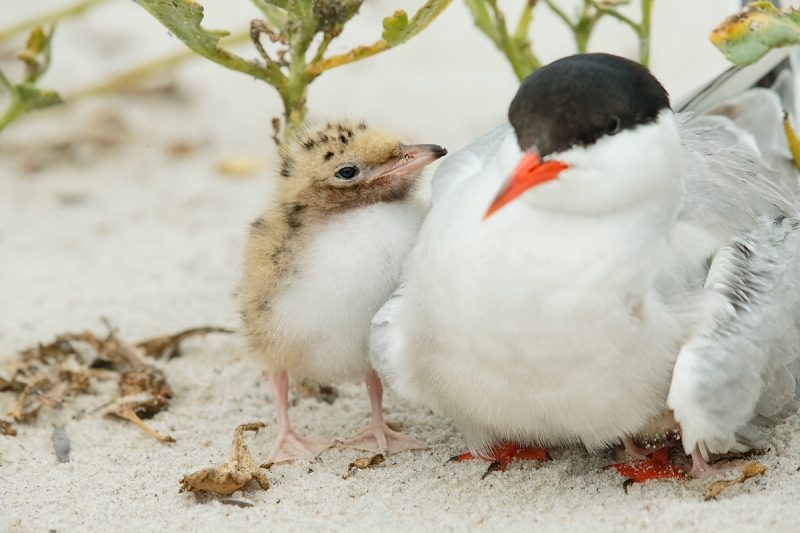
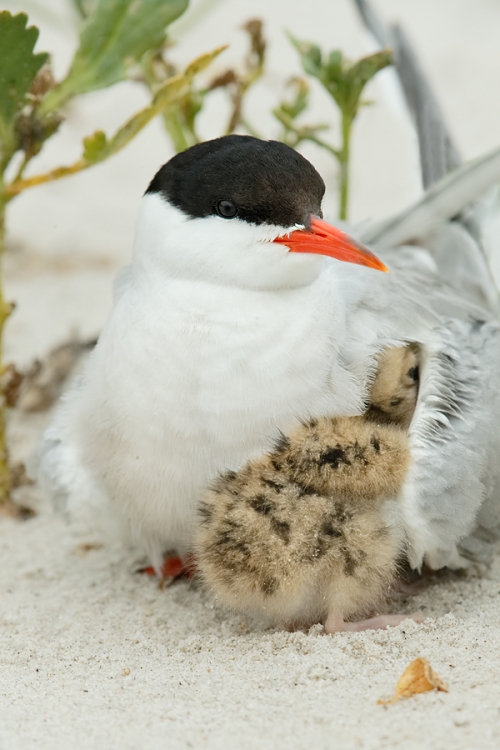
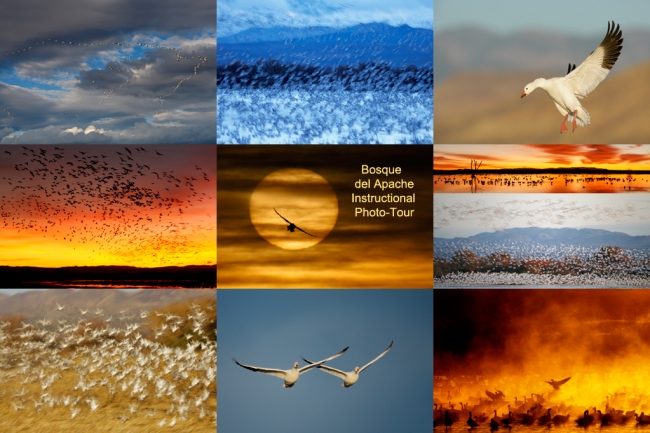
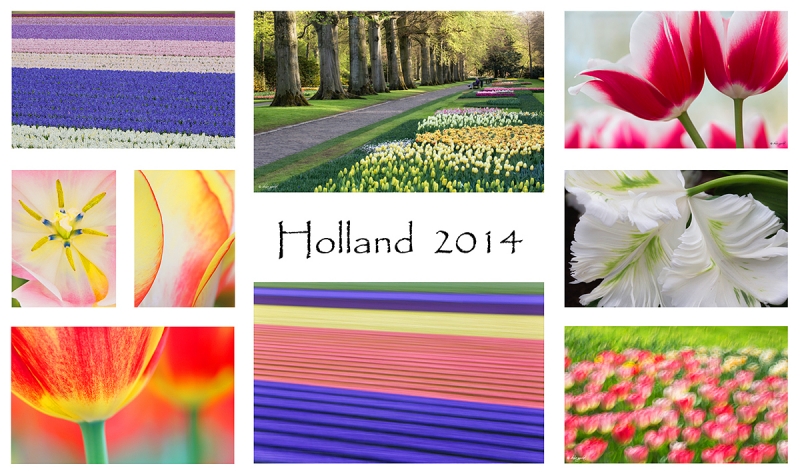
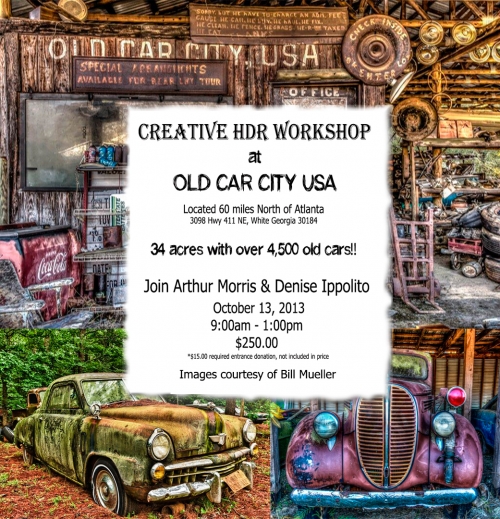













Artie, it warms my heart to read you write about Alan and Pat. They are among the nicest photographers I know. This reminds me that I need to meet up with them again soon 🙂
Agree. So are you. It would be great to see you again on another trip. 🙂
Can you stand at the colony ropes and not disturb the birds?
For the most part we sit so that disturbance is kept to a very minimum. There were several tern nests near the ropes and one outside the ropes. The birds might fly at you head when you approach but are back on their eggs or chicks within a minute. The second egg in the nest outside the ropes hatched during the workshop. We witnessed several feedings.
Hi Artie,
great images, as always. Very cute chick.
I have a question about the 200-400.
Have you ever compared the sharpness of using the 200-400 with internal 1.4x and external 1.4x III and the 200-400 and an external 2x III but with no internal extender?
I wonder what is sharper. f8/784 with 2 1.4x extenders of f8/800 with just the 2x III.
Markus
Hi Markus, I have thought about doing that but have not. I did make one super-sharp image (manually focused) with the internal TC and an external 2X III behind it. The optics are so good that I doubt if normal folks would be able to see any difference between 1.4/1.4 vs. 2X…. artie
First two are killer! Wish I was standing next to you guys! Alan and Pat are awesome photographers and friends!
Agree!
Aw Artie, you say the nicest things! (Urm, I think – it’s a good thing we switched to Canon!) With everything you’ve shared with us I’m glad this time I had something to contribute. Your IPTs have consistently been awesome learning opportunities.
I looked back thru my images and I was mistaken it was a large juvenile (mostly white) tern beating up the infant.
Nikon, Canon, it really does not matter to me. Two of my best friends use Nikon. My very best friend uses Canon. Thanks for your kind words and the extra info on the attack. A juvie makes more sense from an evolutionary standpoint as a chick is a direct competitor for food resources. Love you both. artie
Artie,
You’ve no idea – or maybe you do – how lucky I am that Pat is one of the most tolerant people around. My favorite is also the second, mainly because Pat and I watched a similar chick working on a similar fish for a good 5 or 10 minutes. This fish was covered in sand, I was cringing at the thought of what it must feel like. But glad the chick was getting a huge meal. It finally got all but the last bit of the tail down.
later,
Alan
I’m thinking that we have some idea :).
Hi Art;
Everyday I read your blog. One day I will be able to join you on a workshop. Until then, the blog will remain da bomb!
Hi, Artie. Interesting how hard it is to overcome first impressions; good for you and Alan for making it happen. My favorite is the second image, the chick swallowing a bluefish almost its size. As you likely remember from your childhood catching snappers, bluefish themselves will eat things almost their size, so it seems fitting. And I like the composition, the detail, and the chick’s seeming to be wondering what it’s got itself into. I like the fourth image too; nice showing the mother protecting her baby. I’ve photographed piping plovers and black-backed gulls doing similar.
Making what happen?
Overcoming your initial not-so good impression of Alan.
It was what it was. As I said, I was way wrong on my first impression–that only happens rarely. And Alan was in fact a very nice man. Still is.